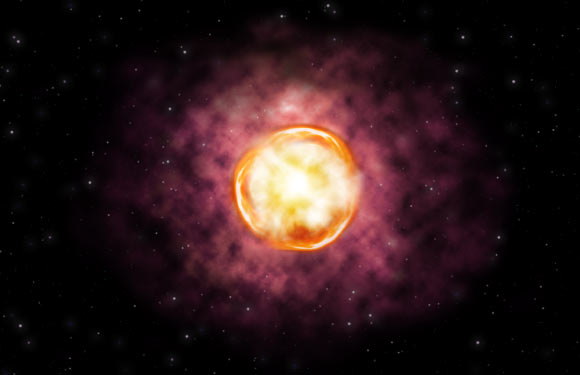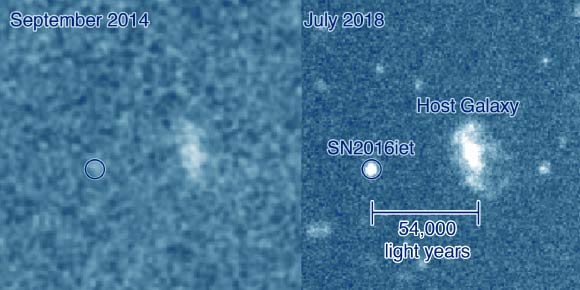New Type of Supernova Totally Annihilates Its Parent Star | Astronomy – Sci-News.com
Astronomers have announced the discovery of the most massive star ever known to be destroyed by a supernova explosion. Dubbed SN 2016iet, the explosive event may represent the way in which the most massive stars in the Universe, including the first stars, end their lives.

An artist’s concept of the SN 2016iet pair-instability supernova. Image credit: Gemini Observatory / NSF / AURA / Joy Pollard.
SN 2016iet occurred in a dwarf galaxy approximately 900 million light-years away.
Also known as Gaia16bvd, the stellar explosion was first spotted by ESA’s star-mapping Gaia satellite on November 14, 2016.
Three years of follow-up observations with a variety of telescopes provided crucial perspectives on its distance and composition.
SN 2016iet has a multitude of oddities, including its incredibly long duration, large energy, unusual chemical fingerprints, and environment poor in heavier elements — for which there are no analogues in the existing astronomical literature.
“When we first realized how thoroughly unusual SN2016iet is my reaction was ‘whoa — did something go horribly wrong with our data?” said Sebastian Gomez, a graduate student at Harvard University.
“After a while we determined that SN2016iet is an incredible mystery, located in a previously uncatalogued galaxy almost one billion light-years from Earth.”
“Everything about this supernova looks different — its change in brightness with time, its spectrum, the galaxy it is located in, and even where it’s located within its galaxy,” said Harvard University’s Professor Edo Berger.
“We sometimes see supernovae that are unusual in one respect, but otherwise are normal; this one is unique in every possible way.”

This image, taken with the Low Dispersion Survey Spectrograph on the Magellan Clay 6.5-m telescope at Las Campanas Observatory on July 9, 2018, shows SN 2016iet and its most likely host galaxy. Image credit: Harvard & Smithsonian Center for Astrophysics.
The observations and analysis show that SN2016iet began as an incredibly massive star about 200 times the mass of our Sun that mysteriously formed in isolation roughly 54,000 light-years from the center of its host galaxy.
The star lost about 85% of its mass during a short life of only a few million years, all the way up to its final explosion and demise.
The collision of the explosion-debris with the material shed in the final decade before explosion led to SN2016iet’s unusual appearance, providing scientists with the first strong case of a pair-instability supernova.
“The idea of pair-instability supernovae has been around for decades,” Professor Berger said.
“But finally having the first observational example that puts a dying star in the right regime of mass, with the right behavior, and in a metal-poor dwarf galaxy is an incredible step forward.”
“SN2016iet represents the way in which the most massive stars in the Universe, including the first stars, die.”
The astronomers will continue to observe and study SN2016iet for years, watching for additional clues as to how it formed, and how it will evolve.
“Most supernovae fade away and become invisible against the glare of their host galaxies within a few months. But because SN2016iet is so bright and so isolated we can study its evolution for years to come,” Gomez said.
“These observations are already in progress and we can’t wait to see what other surprises this supernova has in store for us.”
The findings were published in the Astrophysical Journal (arXiv.org preprint).
_____
Sebastian Gomez et al. 2019. SN 2016iet: The Pulsational or Pair Instability Explosion of a Low Metallicity Massive CO Core Embedded in a Dense Hydrogen-Poor Circumstellar Medium. ApJ 881 (2); doi: 10.3847/1538-4357/ab2f92





